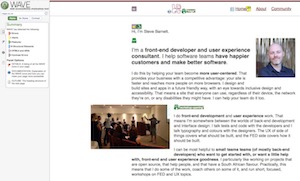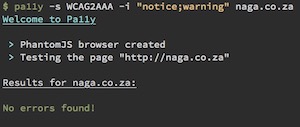Here’s a quick round-up of how I try and write accessible HTML. I use a handful of tools that do similar things from different angles. It’s a mix of command line things, CSS, and my brain.
I use a mix of tools because I try and be a bit pessimistic about how good I’ll be at fixing everything. I want to give future-me several chances to catch the things that past-me overlooked or missed.
My process
Here are the three big steps I do when working on something running on my machine.
- Write semantic HTML. Use the right element for the right thing. Write valid HTML.
- Add CSS debuggers and look in browser. I could have them as bookmarklets, but I prefer them inside the (development) styles. This way I can’t avoid them or forget to test with them.
- Run CLI tools. I use Pa11y and am getting into aXe.
See below for more detail on the CSS debuggers and CLI tools. For things that aren’t running on my machine, I use:
- the aXe Chrome extension;
- Khan Academy’s tota11y;
- Accessiblity Bookmarklets;
- WebAIM’s WAVE when I want to test a page and share the results with someone;
- the Audits tab in Chrome dev tools.
CSS debuggers
I use my fork of Heydon Pickering’s Revenge.css and the warnings and errors files from a11y.css to highlight where I’ve made HTML mistakes.
In the (Jekyll-flavoured) header of this site, you can see that I include some extra CSS files: a11y-en_error.css, a11y-en_warning.css and revenge.css. These add high visibility (especially in revenge’s case!) borders, backgrounds, and words to things that are inaccessible. It’s very difficult to miss them!
Where appropriate, I also add a component-name.test.css that has more specific rules.
CLI tools
I use Pa11y. It can be quite verbose and a bit intimidating, though. For a full check, I run
$ pa11y -s WCAG2AAA the_url
(using -s lets you set the standard you want to use). I usually run just the error check first (ignoring notices and warnings), like this:
$ pa11y -s WCAG2AAA -i "notice;warning" the_url
I’m still figuring out the best way of integrating this with other tests and things. I want to use Gulp aXe web driver as part of the build process in my next project. aXe has a different approach to pa11y. Where pa11y is loud, aXe is quiet: they aim for no false positives, so they output is much quieter.
And you?
How do you test your stuff for accessibility? And if you don’t yet, what’s the first thing you’ll test? Putting a (publicly accessible) URL into WAVE is a great, low effort, first step. Here’s this site put through the wringer. When starting work on a new site, I like to run WAVE and see if there’s one error that I can do a tiny, quick, fix for.

